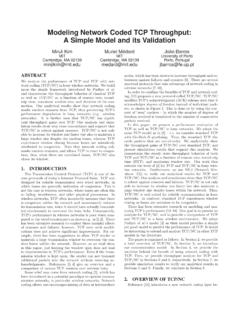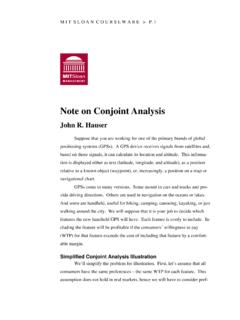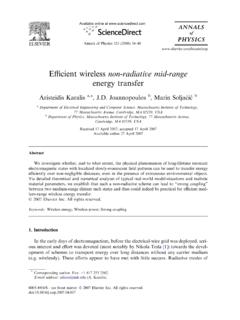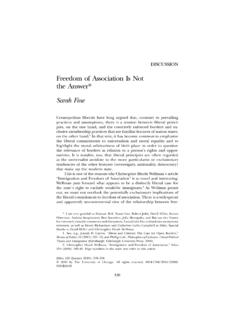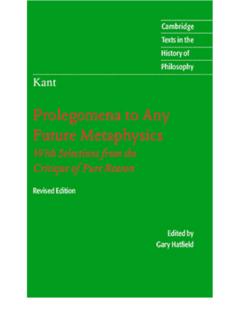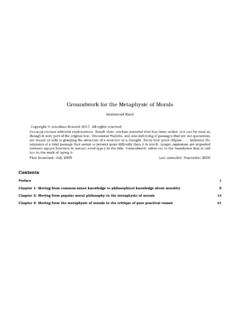Transcription of Introduction from: Distinction: A Social Critique of the ...
1 Introduction from: Distinction: A Social Critique of the Judgement of Taste by Pierre Bourdieu 1984 Introduction You said it, my good knight! There ought to be laws to protect the body of acquired knowledge. Take one of our good pupils, for example: modest and diligent, from his earliest grammar classes he s kept a little notebook full of phrases. After hanging on the lips of his teachers for twenty years, he s managed to build up an intellectual stock in trade; doesn t it belong to him as if it were a house, or money? Paul Claudel, Le soulier de satin, Day III, Scene ii There is an economy of cultural goods, but it has a specific logic. Sociology endeavours to establish the conditions in which the consumers of cultural goods, and their taste for them, are produced, and at the same time to describe the different ways of appropriating such of these objects as are regarded at a particular moment as works of art, and the Social conditions of the constitution of the mode of appropriation that is considered legitimate.
2 But one cannot fully understand cultural practices unless culture , in the restricted, normative sense of ordinary usage, is brought back into culture in the anthropological sense, and the elaborated taste for the most refined objects is reconnected with the elementary taste for the flavours of food. Whereas the ideology of charisma regards taste in legitimate culture as a gift of nature, scientific observation shows that cultural needs are the product of upbringing and education: surveys establish that all cultural practices (museum visits, concert-going, reading etc.), and preferences in literature, painting or music, are closely linked to educational level (measured by qualifications or length of schooling) and secondarily to Social The relative weight of home background and of formal education (the effectiveness and duration of which are closely dependent on Social origin) varies according to the extent to which the different cultural practices are recognized and taught by the educational system, and the influence of Social origin is strongest other things being equal in extra-curricular and avant-garde culture.
3 To the socially recognized hierarchy of the arts, and within each of them, of genres, schools or periods, corresponds a Social hierarchy of the consumers. This predisposes tastes to function as markers of class . The manner in which culture has been acquired lives on in the manner of using it: the importance attached to manners can be 1 Bourdieu et al., Un art moyen: essai sur les usages sociaux de la photographie (Paris, Ed. de Minuit, 1965); P. Bourdieu and A. Darbel, L Amour de l art: les mus es et leur public (Paris, Ed. de Minuit, 1966). 2 understood once it is seen that it is these imponderables of practice which distinguish the different and ranked modes of culture acquisition, early or late, domestic or scholastic, and the classes of individuals which they characterize (such as pedants and mondains).
4 Culture also has its titles of nobility awarded by the educational system and its pedigrees, measured by seniority in admission to the nobility. The definition of cultural nobility is the stake in a struggle which has gone on unceasingly, from the seventeenth century to the present day, between groups differing in their ideas of culture and of the legitimate relation to culture and to works of art, and therefore differing in the conditions of acquisition of which these dispositions are the product2 Even in the classroom, the dominant definition of the legitimate way of appropriating culture and works of art favours those who have had early access to legitimate culture, in a cultured household, outside of scholastic disciplines, since even within the educational system it devalues scholarly knowledge and interpretation as scholastic or even pedantic in favour of direct experience and simple delight.
5 The logic of what is sometimes called, in typically pedantic language, the reading of a work of art, offers an objective basis for this opposition. Consumption is, in this case, a stage in a process of communication, that is, an act of deciphering, decoding, which presupposes practical or explicit mastery of a cipher or code. In a sense, one can say that the capacity to see (voir) is a function of the knowledge (savoir), or concepts, that is, the words, that are available to name visible things, and which are, as it were, programmes for perception. A work of art has meaning and interest only for someone who possesses the cultural competence, that is, the code, into which it is encoded. The conscious or unconscious implementation of explicit or implicit schemes of perception and appreciation which constitutes pictorial or musical culture is the hidden condition for recognizing the styles characteristic of a period, a school or an author, and, more generally, for the familiarity with the internal logic of works that aesthetic enjoyment presupposes.
6 A beholder who lacks the specific code feels lost in a chaos of sounds and rhythms, colours and lines, without rhyme or reason. Not having learnt to adopt the adequate disposition, he stops short at what Erwin Panofsky calls the sensible properties , perceiving a skin as downy or lace-work 2 The word disposition seems particularly suited to express what is covered by the concept of habitus (defined as a system of dispositions) used later in this chapter. It expresses first the result of an organizing action, with a meaning close to that of words such as structure; it also designates a way of being, a habitual state (especially of the body) and, in particular, a predisposition, tendency, propensity or inclination. [The semantic cluster of disposition is rather wider in French than in English, but as this note translated literally shows, the equivalence is adequate.]
7 Translator.] P. Bourdieu, Outline of a Theory of Practice (Cambridge, Cambridge UJniversity Press, 1977), p. 214, n. 1. 3 as delicate, or at the emotional resonances aroused by these properties, referring to austere colours or a joyful melody. He cannot move from the primary stratum of the meaning we can grasp on the basis of our ordinary experience to the stratum of secondary meanings , , the level of the meaning of what is signified , unless he possesses the concepts which go beyond the sensible properties and which identify the specifically stylistic properties of the Thus the encounter with a work of art is not love at first sight as is generally supposed, and the act of empathy, Einf hlung, which is the art-lover s pleasure, presupposes an act of cognition, a decoding operation, which implies the implementation of a cognitive acquirement.
8 A cultural This typically intellectualist theory of artistic perception directly contradicts the experience of the art-lovers closest to the legitimate definition; acquisition of legitimate culture by insensible familiarization within the family circle tends to favour an enchanted experience of culture which implies forgetting the The eye is a product of history reproduced by education. This is true of the mode of artistic perception now accepted as legitimate, that is, the aesthetic disposition, the capacity to consider in and for themselves, as form rather than function, not only the works designated for such apprehension, , legitimate works of art, but everything in the world, including cultural objects which are not yet consecrated such as, at one time, primitive arts, or, nowadays, 3 E.
9 Panofsky, Iconography and Iconology: An Introduction to the Study of Renaissance Art , Meaning in the Visual Arts (New York, Doubleday, 1955), p. 28. 4 It will be seen that this internalized code called culture functions as cultural capital owing to the fact that, being unequally distributed, it secures profits of distinction. 5 The sense of familiarity in no way excludes the ethnocentric misunderstanding which results from applying the wrong code. Thus, Michael Baxandall s work in historical ethnology enables us to measure all that separates the perceptual schemes that now tend to be applied to Quattrocento paintings and those which their immediate addressees applied. The moral and spiritual eye of Quattrocento man, that is, the set of cognitive and evaluative dispositions which were the basis of his perception of the world and his perception of pictorial representation of the world, differs radically from the pure gaze (purified, first of all, of reference to economic value) with which the modern cultivated spectator looks at works of art.
10 As the contracts show, the clients of Filippo Lippi, Domenico Ghirlandaio or Piero della Francesca were concerned to get value for money . They approached works of art with the mercantile dispositions of a businessman who can calculate quantities and prices at a glance, and they applied some surprising criteria of appreciation, such as the expense of the colours, which sets gold and ultramarine at the top of the hierarchy. The artists, who shared this world view, were led to include arithmetical and geometrical devices in their compositions so as to flatter this taste for measurement and calculation; and they tended to exhibit the technical virtuosity which, in this context, is the most visible evidence of the quantity and quality of the labour provided; M. Baxandall, Painting and Experience in Fifteenth-Century Italy: A Primer in the Social History of Pictorial Style (Oxford, Oxford University Press, 1972).
